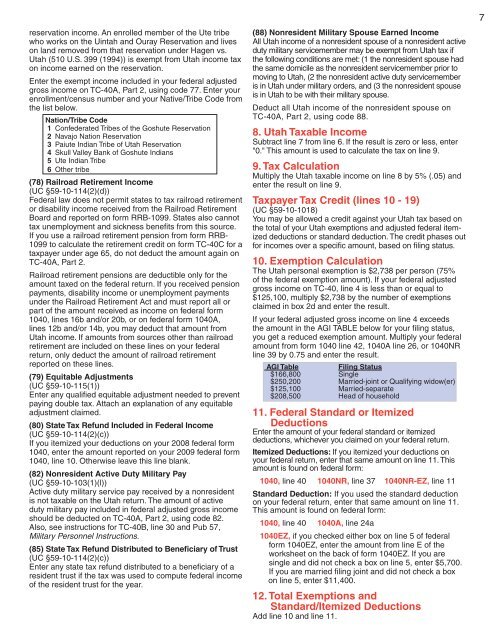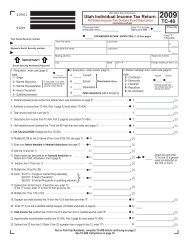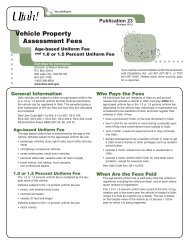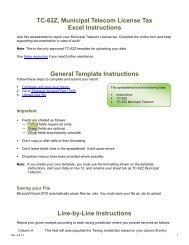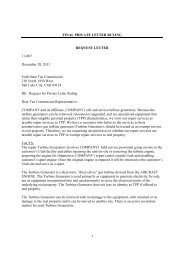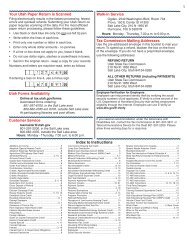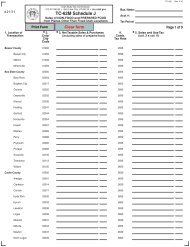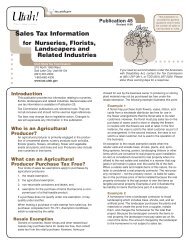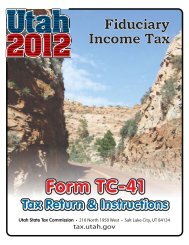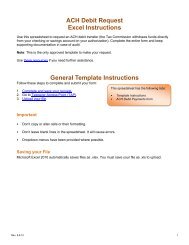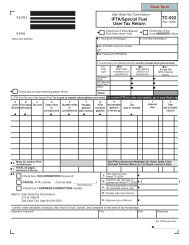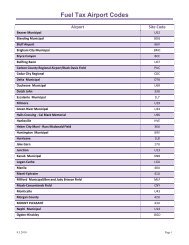2009 Individual Income Tax TC-40 Forms & Instructions
2009 Individual Income Tax TC-40 Forms & Instructions
2009 Individual Income Tax TC-40 Forms & Instructions
Create successful ePaper yourself
Turn your PDF publications into a flip-book with our unique Google optimized e-Paper software.
eservation income. An enrolled member of the Ute tribe<br />
who works on the Uintah and Ouray Reservation and lives<br />
on land removed from that reservation under Hagen vs.<br />
Utah (510 U.S. 399 (1994)) is exempt from Utah income tax<br />
on income earned on the reservation.<br />
Enter the exempt income included in your federal adjusted<br />
gross income on <strong>TC</strong>-<strong>40</strong>A, Part 2, using code 77. Enter your<br />
enrollment/census number and your Native/Tribe Code from<br />
the list below.<br />
Nation/Tribe Code<br />
1 Confederated Tribes of the Goshute Reservation<br />
2 Navajo Nation Reservation<br />
3 Paiute Indian Tribe of Utah Reservation<br />
4 Skull Valley Bank of Goshute Indians<br />
5 Ute Indian Tribe<br />
6 Other tribe<br />
(78) Railroad Retirement <strong>Income</strong><br />
(UC §59-10-114(2)(d))<br />
Federal law does not permit states to tax railroad retirement<br />
or disability income received from the Railroad Retirement<br />
Board and reported on form RRB-1099. States also cannot<br />
tax unemployment and sickness benefi ts from this source.<br />
If you use a railroad retirement pension from form RRB-<br />
1099 to calculate the retirement credit on form <strong>TC</strong>-<strong>40</strong>C for a<br />
taxpayer under age 65, do not deduct the amount again on<br />
<strong>TC</strong>-<strong>40</strong>A, Part 2.<br />
Railroad retirement pensions are deductible only for the<br />
amount taxed on the federal return. If you received pension<br />
payments, disability income or unemployment payments<br />
under the Railroad Retirement Act and must report all or<br />
part of the amount received as income on federal form<br />
10<strong>40</strong>, lines 16b and/or 20b, or on federal form 10<strong>40</strong>A,<br />
lines 12b and/or 14b, you may deduct that amount from<br />
Utah income. If amounts from sources other than railroad<br />
retirement are included on these lines on your federal<br />
return, only deduct the amount of railroad retirement<br />
reported on these lines.<br />
(79) Equitable Adjustments<br />
(UC §59-10-115(1))<br />
Enter any qualifi ed equitable adjustment needed to prevent<br />
paying double tax. Attach an explanation of any equitable<br />
adjustment claimed.<br />
(80) State <strong>Tax</strong> Refund Included in Federal <strong>Income</strong><br />
(UC §59-10-114(2)(c))<br />
If you itemized your deductions on your 2008 federal form<br />
10<strong>40</strong>, enter the amount reported on your <strong>2009</strong> federal form<br />
10<strong>40</strong>, line 10. Otherwise leave this line blank.<br />
(82) Nonresident Active Duty Military Pay<br />
(UC §59-10-103(1)(l))<br />
Active duty military service pay received by a nonresident<br />
is not taxable on the Utah return. The amount of active<br />
duty military pay included in federal adjusted gross income<br />
should be deducted on <strong>TC</strong>-<strong>40</strong>A, Part 2, using code 82.<br />
Also, see instructions for <strong>TC</strong>-<strong>40</strong>B, line 30 and Pub 57,<br />
Military Personnel <strong>Instructions</strong>.<br />
(85) State <strong>Tax</strong> Refund Distributed to Benefi ciary of Trust<br />
(UC §59-10-114(2)(c))<br />
Enter any state tax refund distributed to a benefi ciary of a<br />
resident trust if the tax was used to compute federal income<br />
of the resident trust for the year.<br />
(88) Nonresident Military Spouse Earned <strong>Income</strong><br />
All Utah income of a nonresident spouse of a nonresident active<br />
duty military servicemember may be exempt from Utah tax if<br />
the following conditions are met: (1 the nonresident spouse had<br />
the same domicile as the nonresident servicemember prior to<br />
moving to Utah, (2 the nonresident active duty servicemember<br />
is in Utah under military orders, and (3 the nonresident spouse<br />
is in Utah to be with their military spouse.<br />
Deduct all Utah income of the nonresident spouse on<br />
<strong>TC</strong>-<strong>40</strong>A, Part 2, using code 88.<br />
8. Utah <strong>Tax</strong>able <strong>Income</strong><br />
Subtract line 7 from line 6. If the result is zero or less, enter<br />
"0." This amount is used to calculate the tax on line 9.<br />
9. <strong>Tax</strong> Calculation<br />
Multiply the Utah taxable income on line 8 by 5% (.05) and<br />
enter the result on line 9.<br />
<strong>Tax</strong>payer <strong>Tax</strong> Credit (lines 10 - 19)<br />
(UC §59-10-1018)<br />
You may be allowed a credit against your Utah tax based on<br />
the total of your Utah exemptions and adjusted federal itemized<br />
deductions or standard deduction. The credit phases out<br />
for incomes over a specifi c amount, based on fi ling status.<br />
10. Exemption Calculation<br />
The Utah personal exemption is $2,738 per person (75%<br />
of the federal exemption amount). If your federal adjusted<br />
gross income on <strong>TC</strong>-<strong>40</strong>, line 4 is less than or equal to<br />
$125,100, multiply $2,738 by the number of exemptions<br />
claimed in box 2d and enter the result.<br />
If your federal adjusted gross income on line 4 exceeds<br />
the amount in the AGI TABLE below for your fi ling status,<br />
you get a reduced exemption amount. Multiply your federal<br />
amount from form 10<strong>40</strong> line 42, 10<strong>40</strong>A line 26, or 10<strong>40</strong>NR<br />
line 39 by 0.75 and enter the result.<br />
AGI Table Filing Status<br />
$166,800 Single<br />
$250,200 Married-joint or Qualifying widow(er)<br />
$125,100 Married-separate<br />
$208,500 Head of household<br />
11. Federal Standard or Itemized<br />
Deductions<br />
Enter the amount of your federal standard or itemized<br />
deductions, whichever you claimed on your federal return.<br />
Itemized Deductions: If you itemized your deductions on<br />
your federal return, enter that same amount on line 11. This<br />
amount is found on federal form:<br />
10<strong>40</strong>, line <strong>40</strong> 10<strong>40</strong>NR, line 37 10<strong>40</strong>NR-EZ, line 11<br />
Standard Deduction: If you used the standard deduction<br />
on your federal return, enter that same amount on line 11.<br />
This amount is found on federal form:<br />
10<strong>40</strong>, line <strong>40</strong> 10<strong>40</strong>A, line 24a<br />
10<strong>40</strong>EZ, if you checked either box on line 5 of federal<br />
form 10<strong>40</strong>EZ, enter the amount from line E of the<br />
worksheet on the back of form 10<strong>40</strong>EZ. If you are<br />
single and did not check a box on line 5, enter $5,700.<br />
If you are married fi ling joint and did not check a box<br />
on line 5, enter $11,<strong>40</strong>0.<br />
12. Total Exemptions and<br />
Standard/Itemized Deductions<br />
Add line 10 and line 11.<br />
7


